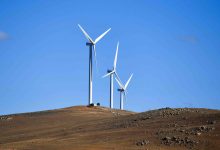A Covid recovery plan based around wind, solar and energy efficiency would deliver a stronger economic recovery for Australia, with lower unemployment, higher living standards, and contained government debt, an independent analysis by former Treasury economist Chris Murphy has found.
Murphy, a public policy expert who currently works at the Australian National University’s Arndt-Corden Department of Economics, modelled the national economic impacts of Beyond Zero Emissions’ Million Jobs Plan, which was launched in June and championed by software billionaire and Atlassian CEO Mike Cannon-Brookes, who is backing several of the plan’s bigger projects.
As RenewEconomy has reported here, and BZEs Eytan Lenko explains himself here, the comprehensive Million Jobs Plan proposes up to 90GW of new wind and solar projects be built, alongside investment in improving housing energy performance, better public transport systems and a rejuvenated Australian manufacturing sector based around green exports.
The BZE Plan found that around three times as many jobs were created by investments in renewable energy and energy compared to the same level of investment in the fossil fuel industry – a fact that has not stopped the federal Morrison government from opting to back a gas-led recovery, including subsidies promised to extend gas infrastructure and open up new gas basins.
And this week, Murphy – whose services have been commissioned twice by Treasury over the past four years – has added his expert opinion to the many arguing that a green and renewable energy-focused policy plan such as that modelled by BZE would provide a much better pathway out of the Covid-19 recession.
It has now been presented to government. “This is a huge step. The BZE Million Jobs Plan now has a solid economic model behind it,” Cannon-Brookes tweeted on Thursday. “Ticks for GDP, Jobs and Energy Prices. We need a green & gold recovery.”
Cannon-Brookes, of course, is a supporter of some of the plans stellar projects, including the massive Sun Cable solar and storage project in the Northern Territory, and a possible trans-continental link of HVDC power lines to share renewable energy between the east and west.
Murphy said in a statement on Thursday that his modelling of the national economic impacts of this Plan shows that it contributes to a stronger economic recovery from the COVID-19 recession.
“It does this by adding an average of $25 billion to private investment over the next three years as Plan projects are developed,” he said, noting that it would deliver results almost immediately and benefits that would persist for many years.
“In the medium to long term, the additional investment in low-carbon technologies in areas such as housing, electricity generation and transmission and manufacturing contributes to higher productivity,” Muphy explains.
“This means that real after-tax wages are 1% higher in 2022-23 and 2% higher by 2035-36 than they would be without the Plan. Similarly, higher productivity adds between 1% and 2% to GDP.”
Murphy’s modelling finds that the BZE Plan’s approach of using government support to leverage private investment would help stabilise government finances, compared to alternative strategies that will rely more on public spending.
It also finds that by as early as the 2021 financial year, the BZE plan would create an estimated 124,000 more jobs than would exist without it – an important number considering 740,000 Australians were reported to be on JobSeeker in regional areas alone in June. According to Muphy’s modelling, more than 70% of the jobs created would be in those same regional areas.
“In all, the key to a stronger economic recovery with lower unemployment, higher living standards and contained government debt will be policies like this Plan that stimulate higher, productive private investment,” he said.










